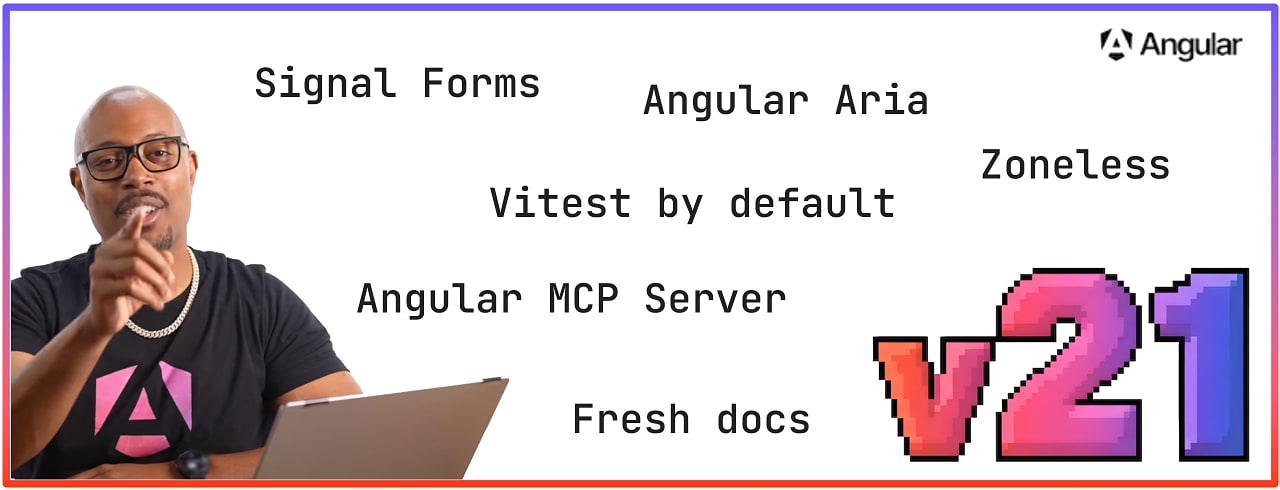21 Nov 2025
|
Google Announces Angular v21 - The Google team has gone all out with this significant release of its popular JavaScript framework. They've put together a retro game-themed adventure-based tour of what's new, along with top notch videos showing off features like its new signal-based approach to forms, MCP server for AI-powered workflows, library of headless components focused on accessibility, and even a new 'Angular AI Tutor' to get up to speed.
Google
|
|
This week's TC39 meeting: The Ecma TC39 committee (the group behind the design of ECMAScript / JavaScript) met up for the 111th time this week (seen above) to discuss language proposals. The meeting notes won't be published for a few weeks, but several proposals did see some progress:
Note: Learn more about what the TC39 stages mean here.
|
|
Tooltip Components Should Not Exist - Dominik challenges some common wisdom in his typically erudite fashion. Stand-alone tooltip components are the wrong abstraction when separated from the underlying UI features that use them. This thinking can apply to many other UI affordances too, so the broad idea is well worth considering.
Dominik Dorfmeister (AKA TkDodo)
|
|
TanStack DB 0.5, Now with Query-Driven Sync - TanStack DB is a client‑first reactive data store that uses differential dataflow to power live, relational queries, sub‑ms incremental updates, and seamless optimistic writes. In v0.5, a component's query becomes the API call too. "Just write your query and TanStack DB figures out exactly what to fetch."
Willis, De Parre, and Matthews
|
|
Still Writing Tests Manually? - See why modern engineering teams like Dropbox, Notion and Lattice rely on Meticulous to run E2E UI tests.
Meticulous AI sponsor
|
|
📢 Elsewhere in the ecosystem
|
|
Some other interesting tidbits in the broader landscape:
|
|

21 Nov 2025 12:00am GMT
18 Nov 2025
In a three-article series published recently on this site (Part 1, Part 2, Part 3), I've been demonstrating the power of the AWS Cloud Development Kit (CDK) in the Infrastructure as Code (IaC) area, especially when coupled with the ubiquitous Java and its supersonic/subatomic cloud-native stack: Quarkus.
While focusing on the CDK fundamentals in Java, like Stack and Construct, together with their Quarkus implementations, this series was a bit frugal as far as the infrastructure elements were concerned. Indeed, for the sake of clarity and simplification, the infrastructure used to illustrate how to use the CDK with Java and Quarkus was inherently consensual. Hence, the idea for a new series, of which this article is the first, is a series less concerned with CDK internals and more dedicated to the infrastructure itself.
18 Nov 2025 3:00pm GMT
Troubleshooting memory problems, such as memory leaks and OutOfMemoryError, can be an intimidating task even for experienced engineers. In this post, we would like to share simple tips, tools, and tricks so that even a novice engineer can isolate memory problems and resolve them quickly.
What Are Common Signs of a Java Memory Leak That Might Lead to OutOfMemoryError?
Before your application throws an OutOfMemoryError, it usually gives you a few warning signs. If you catch them early, you can prevent downtime and customer impact. Here's what you should keep an eye on:
18 Nov 2025 2:00pm GMT
14 Nov 2025
|
JavaScript Engines Zoo: Learn About Over 100 JS Engines - I'm a sucker for a big table of data and this is about as big as it gets when it comes to JavaScript engines. See how various engines compare, sort them by performance, or click on an engine's name to learn more about its development, history, and end users. The project's repo also has Dockerfiles for trying each of them out.
Ivan Krasilnikov
|

FlexGrid by Wijmo: The Industry-Leading JavaScript Datagrid - A fast and flexible datagrid for building modern web apps. Key features and virtualized rendering are included in the core grid module. Pick & choose special features to keep your app small. Built for JavaScript, extended to Angular, React, and Vue.
Wijmo From MESCIUS sponsor
|
|
Valdi: Snap's Newly-Open Cross-Platform UI Framework - The team behind Snapchat has open sourced this cross-platform UI framework that it's used in its production apps for eight years: "Write your UI once in declarative TypeScript, and it compiles directly to native views on iOS, Android, and macOS-no web views, no JavaScript bridges."
Snap
|
|
💡 Valdi's FAQ answers several questions you might have, including how it works and why you might pick Valdi over React Native.
|
|
▶ The State of Node.js in 2025, Explained - A thirty-minute talk from JSNation earlier this year where TSC member Matteo Collina presented an update on Node's still-growing popularity, release schedule, security, recent performance enhancements, the permissions system, and more.
GitNation
|
|
V8's Garbage Collector Developments in Recent Years - Andy, who's worked on both V8 and JavaScriptCore in the past, reviews the major developments in the V8 engine's garbage collector over the past couple of years. Very technical, but a valuable piece of history.
Andy Wingo
|
|
pnpm 10.21: Safer Installs and Smarter Runtime Management - Now installs the Node version required by a dependency, declared in its engines.runtime field, meaning CLI apps and postinstall scripts will run with the specified version. The trustPolicy setting also adds protection against supply-chain attacks by failing to install a package if its trust level drops.
Zoltan Kochan
|
|
📢 Elsewhere in the ecosystem
|
|
Some other interesting tidbits in the broader landscape:
|
|
🎂 P.S. JavaScript Weekly turned fifteen years old this week! Thanks to all of you for reading, and particularly anyone still subscribed from the first issue. We haven't looked at the stats in a while, but we know there are some of you! :-)
|
|

14 Nov 2025 12:00am GMT
13 Nov 2025
In Spring, the ApplicationContext is the central container object that manages all beans (i.e., components, services, repositories, etc.).
Its tasks include reading the configuration (Java Config, XML, annotations), creating and managing bean instances, handling dependency injection, and running the application lifecycle.
13 Nov 2025 5:00pm GMT
07 Nov 2025
|
The Inner Workings of JavaScript Source Maps - Ever wondered how devtools can magically turn mangled, minified JavaScript back into readable source while debugging? Zero magic; that's a source map doing its job. But how do source maps actually work under the hood?
Manoj Vivek
|

Ship Secure MCP Auth Without Relying on API Keys - API keys are hard to scope and break user flows. WorkOS Connect delivers a fully compliant OAuth 2.1 flow. It handles PKCE, scopes, user consent, and secure token issuance out of the box.
WorkOS sponsor
|
|
Embedding TypeScript with Hako - A technical look at the Hako JavaScript engine. It runs in WebAssembly so can be more easily embedded in more environments, including mobile apps.
Andrew Sampson
|
|
How to Throttle Specific Requests in Chrome DevTools - Chrome DevTools has supported network throttling for a long time but you can now throttle requests to specific URLs or domains too, which could be ideal if you want to see how your site handles the failure of third party scripts.
Matt Zeunert
|
|
📢 Elsewhere in the ecosystem
|
|
A roundup of some other interesting stories in the broader landscape:
|
|

07 Nov 2025 12:00am GMT
11 Aug 2025
It's here! Almost. jQuery 4.0.0-rc.1 is now available. It's our way of saying, "we think this is ready; now poke it with many sticks". If nothing is found that requires a second release candidate, jQuery 4.0.0 final will follow. Please try out this release and let us know if you encounter any issues. A 4.0 … Continue reading →
11 Aug 2025 5:35pm GMT
05 Aug 2025
BRZ migrated the Austrian Business Service Portal with 2M+ users to Keycloak. The Austrian Business Service Portal (USP) is the central online eGovernment platform for entrepreneurs and businesses. It connects businesses with various Austrian online government services, where businesses can access all digital services and information in one place. The USP was launched in 2010 by the (BRZ, abbreviated from the German name Bundesrechenzentrum). The BRZ is the market-leading eGovernment partner of the Austrian federal administration and is both developing and operating the portal. Authenticating and authorizing 2+ million users for 130+ public services is the most important key feature of the USP which now uses Keycloak, microservices and GitOps under the hood. ! We are now starting to collect all case studies at . If you want to share your case study with the Keycloak community, to sort out the details.
05 Aug 2025 12:00am GMT
13 Jul 2025
These are some of the blogs I follow for high-signal content, real-world lessons, and emerging patterns. 1. The Burning Monk (Yan Cui) - Deep technical guides, real-world insights, and event-driven serverless at its best. 🔗 2. Off-by-none (Jeremy Daly) - Weekly curated newsletter filled with top serverless news, tools, and community updates. 🔗 3. A Cloud Guru Blog - Trusted training content with strong coverage of AWS, certifications, and serverless how-tos. 🔗 4. Serverless.com Blog - Official blog for the Serverless Framework team with tutorials, product updates, and ecosystem insights. 🔗 5. AWS Community Builders Blog - Real-world articles from active AWS contributors and thought leaders. 🔗 6. Serverless Transformation (Aleios) - Strategy-rich serverless insights, especially around event-driven architecture. 🔗 7. AWS Compute Blog - Deep dives into AWS Lambda, Step Functions, and compute services directly from AWS. 🔗 8. AWS Architecture Blog - High-level cloud-native architecture practices and guidance for scalable apps. 🔗 9. Lumigo Blog - Focused on observability, monitoring, and debugging in serverless environments. 🔗 10. Serverless360 Blog - Azure-first serverless content with strong focus on Azure Functions and service management. 🔗 11. Nick Tune's Blog - Sociotechnical thinking and service design strategies for microservices and serverless. 🔗 12. AWS Enterprise Strategy Blog - Executive cloud transformation strategies, ideal for leadership and enterprise architects. 🔗 13. Theodo Blog - Engineering-led content featuring serverless, migration, and rapid product delivery stories. 🔗 14. Serverless First (Paul Swail) - Practical daily tips, guides, and architecture breakdowns from an experienced consultant. 🔗 15. Serverless Land - AWS-curated library of patterns, tutorials, and EDA content for serverless professionals. 🔗 16. Lego Engineers Blog (Sheen Brisals & team) - Real enterprise-scale implementation stories from a global brand. 🔗 17. Serverless Chats Podcast - Interviews with top serverless minds - with full transcripts for every episode. 🔗 18. Serverless Guru Blog - Transformation-focused advice and engineering best practices from a consultancy team. 🔗 19. The Serverless Edge Blog - Cloud strategy, org design, and the "value flywheel effect" in serverless transformation. 🔗 20. InfoQ Serverless - Aggregated industry-wide coverage, articles, and videos on serverless and architecture. 🔗 21. Jeremy Daly's Personal Blog - Detailed architectural posts and in-depth serverless exploration beyond the newsletter. 🔗 22. Lee Gilmore's Blog - Valuable insights on enterprise serverless adoption and scaling strategies. 🔗 23. Ready, Set, Cloud (Allen Helton) - Friendly, digestible blog posts with great diagrams and tutorials. 🔗 24. Sheen Brisals's Blog - Engineering leadership perspectives with an emphasis on EDA and maturity. 🔗 25. Aiden Steele's Blog - Low-level AWS insights with rare gems on Lambda internals and advanced configurations. 🔗 26. Luc van Donkersgoed's Blog - Visual, simple explanations of complex cloud patterns and serverless tips. 🔗 27. Benjamen Pyle's Blog (Binary Heap) - Great technical content on building serverless in Rust. 🔗 28. Ben Kehoe's Blog - Deep strategic thinking on cloud operations, organizational design, and serverless ops. 🔗 29. Alex DeBrie's Blog - Author of The DynamoDB Book, Alex shares thorough serverless data modeling guides. 🔗 30. Last Week in AWS (Corey Quinn) - Hilarious, opinionated, and insightful commentary on all things AWS - including serverless. 🔗 31. AWS Fundamentals Blog - Accessible cloud concepts from community experts. 🔗 32. Vadym Kazulkin on Dev.to - Detailed explorations of Lambda SnapStart and Java serverless.🔗 33. Cloudonaut Blog (Wittig Brothers) - Production-grade AWS best practices and architectural tips. 🔗 Do you know other technical blogs on serverless or cloud? Comment below and share your favorites.
13 Jul 2025 8:59am GMT
19 Mar 2025
17 Jul 2024
Last February, we released the first beta of jQuery 4.0.0. We're now ready to release a second, and we expect a release candidate to come soon™. This release comes with a major rewrite to jQuery's testing infrastructure, which removed all deprecated or under-supported dependencies. But the main change that warranted a second beta was a … Continue reading →
17 Jul 2024 2:03pm GMT
17 Apr 2024
jQuery's influence on the web will always be evident. When it was first introduced in 2006, jQuery became a fundamental tool for web developers almost immediately. It simplified JavaScript programming, making it easier to manipulate HTML documents, handle events, perform animations, and much more. Since then, it has played and continues to play a major … Continue reading →
17 Apr 2024 5:00pm GMT
 JavaScript Weekly
JavaScript Weekly DZone Java Zone
DZone Java Zone JavaScript Weekly
JavaScript Weekly DZone Java Zone
DZone Java Zone JavaScript Weekly
JavaScript Weekly Official jQuery Blog
Official jQuery Blog JBoss Blogs
JBoss Blogs JBoss Blogs
JBoss Blogs JBoss Blogs
JBoss Blogs Official jQuery Blog
Official jQuery Blog Official jQuery Blog
Official jQuery Blog














